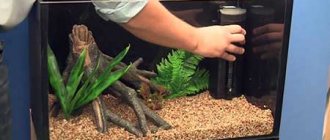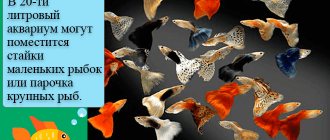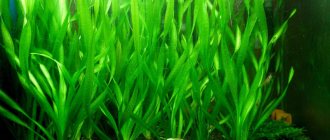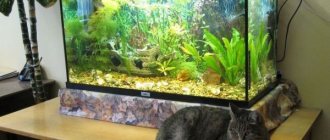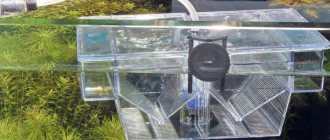Preparing plants for planting
Before purchasing a new plant, it is advisable to find out the conditions in which it will grow and bloom well, acquire brightly colored foliage and will not suffer from proximity to fish and other inhabitants of water bodies. You will have to choose herbs for an already running aquarium, taking into account the existing conditions in it (hydrochemical indicators of water, its temperature, tank volume).
After purchase, the new plant is inspected and its initial processing is carried out:
- remove leaves damaged during transportation;
- remove discovered clutches of snail eggs;
- shorten or divide the rhizome (a number of plants can be propagated immediately in this way);
- cut off crushed, broken roots (otherwise they will rot after planting);
- in plants with a fibrous root system (cryptocoryne, vallisneria, echinodorus), thin roots are shortened by 1/2-1/3 if they are too long.
It is not recommended to shorten thin, weak roots (long-stemmed plants, mosses, ferns, etc.). Only broken root threads can be removed.
Before planting, cut off old and yellowed leaves, and remove broken and damaged roots.
Before planting in an aquarium, the purchased bush must be treated with disinfectant liquids:
- methylene blue solution (0.5 g/l) – effective against bacteria and fungi, mollusks;
- potassium permanganate (1 g/l) – acts on pathogenic microflora, planaria, hydra, etc.;
- table salt (5 g/l) – destroys microorganisms;
- special preparations (Sera costapur, Tetra Medica Contralck, etc.) according to the instructions or in a double dose to disinfect an individual plant - fight pathogens of fish infections.
In order not to introduce rapidly growing green algae into the aquarium (for example, blackbeard, etc.), additional treatment with algaecides is carried out. Antiborodine and other drugs can be purchased at a pet store. A solution of the pharmaceutical drug Streptomycin (0.5 g per 1 liter of water) will also have the desired effect.
The disinfectant solution is poured into a wide container. Greens are immersed in it for 10-15 minutes, unless otherwise indicated in the instructions. After this, the grass is washed under running water (or from a tap). After treatment, plants are planted in the aquarium.
Getting rid of bacteria
To prevent new plants from introducing bacteria and diseases into the aquarium, they must be quarantined and treated before planting.
You can treat plants with a 1:19 chlorine solution (1 part bleach to 19 parts water). Plants are immersed in the solution for 2 - 3 minutes and then thoroughly washed with fresh water. After a week of quarantine, they can be planted in the aquarium.
How to plant bulbous specimens
Part of the aquarium flora has a special organ - the bulb. It stores nutrients that maintain the viability of the bush during the dormant period. Bulbous plants include nymphs, aponogetons, barclays and crinums. All of them are decorative foliage and beautifully flowering specimens.
Bulbous aquarium plants can be planted directly into the aquarium soil.
Planting in the ground does not cause any difficulties:
- You can plant it either in a separate pot or in soil that is poured onto the bottom;
- the root system is well developed; when planting, it is shortened as necessary;
- nutrient substrates are optional (before the roots grow, the bush will receive nutrition from the reserve of the bulb, and then from organic matter clogged into the soil);
- For properly planted bulbs, the upper part should be above the ground, since leaves will appear from the growing point (if dormant bulbs are purchased).
When planting in a container, soil is placed at the bottom (for example, coastal silt), the bulb is placed, straightening the roots, sprinkled with river sand or synthetic backfill, leaving the top of the bulb free with or without foliage. If the plant has not yet sprouted, place the container in warm water (+27°C) and place it under a bright lamp until germination. The container can then be transferred to a pond.
Optional equipment.
Here's the situation. If the room is +14 in winter, then a heater is strictly necessary, but if it is not lower than 21, then you can get by. The filter is external or internal - mainly depending on the amount of fish. It is not a strictly necessary device. Plants need some mobility of water, but even fish can provide it.
Carbon dioxide (CO2) supply system.
It simplifies a lot, quite possibly later you will come to understand the need to supply CO2, but now we are trying to grow at least something. Let's put it aside. As well as automatic fertilizer dispensers, etc., etc.
Photo of an aquarium from Masha Blum's salon.
How to plant rosette aquarium plants
Rosette specimens form a bunch of leaves emerging from 1 point. The stem of such herbs is short, and all the petioles look like growing together, like a bulbous herb. Unlike the latter, rosette aquaflora (cryptocorynes, echinodorus, saggitaria, pistia, water hyacinths, vallisneria, etc.) do not have a storage organ in the form of a bulb or corm. The root system of such plants is fibrous, thin roots grow from the base of the bush in different directions.
If the plant is not a floating one (pistia, hyacinth, etc.), then it will have to be planted directly in the ground or in a container. When planting in a pot, proceed as given in the description for the bulbs. Unlike terrestrial plants, aquatic flora does not need drainage layers, and a silty substrate or a mixture of clay and peat is placed directly into the planting container.
Rosette aquarium plants can be divided before planting or, on the contrary, secured with a plastic clip so that the bush does not crumble when planted.
Digging rosettes into the sand at the bottom, use special substrates or tablets for aquaflora. Experienced aquarists also mix clay and peat in equal proportions and form balls from this mass, which are placed at the roots of the grass when planting. This provides the bush with nutrition in the form of organic and mineral substances.
When planting rosettes yourself, it is important to comply with the only requirement: the root collar (the place where the roots go down and the foliage goes up) should not sink into the soil, nor rise above it. The substrate level passes exactly along the boundary between the above-ground and underground parts.
How to plant plants with horizontal roots
Aquarium plants with horizontal or aerial roots must be carefully secured in the ground using a sinker.
Planting aquarium plants with rhizomes is complicated by the fact that in most varieties it is impossible to dig this part into the sand. All growth points from which leaves or branches are formed are located on the surface, and the rhizome must lie on the substrate.
The trunks from which both rhizoids and leaves arise (for example, in ferns) are poorly retained at the bottom. They practically do not form branched roots and constantly float to the surface of the water. You can secure them by pressing down the rhizome with a stone or decorative element. You can also weigh down the bush with a sinker made of lead wire or plate.
To feed such specimens, special organomineral substrates are almost not used: plants receive most of their nutrients from water, or thin roots absorb nitrogenous substances from organic residues.
4. Correct water temperature
For all tropical plants, the optimal water temperature is 20-26ºC. Water temperatures that are too low result in slow plant growth, stunted growth and poor health. Too high a water temperature leads to a significant increase in their aging. To ensure that our plants have the right temperature, it is best to use heaters with a thermostat, which should work around the clock. Sharp fluctuations in water temperature have a particularly negative effect on the development of delicate plant species.
An important parameter is also the uniform heating of water - it is necessary that at each point of the aqua there is the same temperature. To do this we must install a heater near the filter outlet. A good solution is to additionally use heating cables under or in the ground (necessarily with a thermostat). Warming the earth 1-2ºC above the water temperature causes natural convective movement of water - warmer water slowly rises up, cooler water moves down. These movements cause constant circulation of water in the aquarium, which causes additional positive effects:
- nutrients in water are transported to the ground,
- the final metabolic products of beneficial bacteria living in the substrate are removed from the substrate,
- Plant roots are constantly provided with fresh water and minerals necessary for rapid and stable plant growth.
Other aquarium plants
Other varieties of herbs grown in aquariums include:
- Floating plants. Small representatives of this group (duckweed, riccia, salvinia) do not have developed roots. Large species (pistia, water hyacinth, etc.) have hanging roots that absorb nutrients from the water. These herbs do not need to be anchored to the ground.
- Long-stemmed plants. They are often used as floating ones, but can also be fixed to the bottom. The root threads of ludwigia, elodea, limnophila, cabomba, hornwort, etc. are few and smooth. You can hold the lower parts of the stems using weights: wrap a bunch of stems with wire, pass them through a glass tube, or press them down with a stone.
- Mosses and algae, other small plants. Low-growing grasses (anubias, marsilia, sitnyag, naiad, Java moss, etc.) are difficult to dig into the substrate due to their miniature size. Bushes with a developed root system or rhizomes are secured in the same way as tall grasses, using a sinker. Moss on a stone or driftwood is fixed with a thin fishing line or thread. Cladophora algae balls are lowered to the bottom without securing them.
Preparing the soil
Marble aquarium soil.
The soil plays an important role in creating the ecological system in the aquarium. It nourishes plants and serves as a biological filter, a habitat for beneficial microorganisms.
A distinction is made between substrate and soil. The substrate contains nutrients for plants. They are also present in the soil, but in smaller quantities. Its main purpose is to cover the bottom of the aquarium.
A substrate is required if you plan to plant a large number of plants. It is laid only where they will be located, for example in a corner. If there are few plants, do without a substrate, otherwise it will release nutrients into the water, causing algae to rapidly develop.
Some aquarists do not arrange a substrate, but mix the soil with starting fertilizer.
Fine-grained soil is suitable for most plants. If you intend to keep goldfish, they need large pebbles, which they swallow when they pick up food. When the needs of plants and animals do not coincide, they buy different soils: with small and large grains. They are not mixed, but made into a “sandwich”: small ones are placed on the bottom for plants, and large ones on top for fish.
Before making the base, the soil is washed and doused with boiling water several times. Place on the bottom and level with a spatula. More often they are placed unevenly: a thin layer in front, a thick layer in the back. For plants to develop normally, at least 4 cm of soil is required.
How to properly place plants in an aquarium
There are rules for decorating a pond. The construction of the composition is reminiscent of a theater stage: the audience should be presented with several plans, in each of which both background and accent groups are used.
Foreground decoration
When choosing greenery, preference is given to low-growing plants that quickly spread along the bottom (anubias, small cryptocorynes, marsilia, etc.). They look good in small aquariums, because they rarely reach 5 cm in height. Open “lawns” in the foreground can occupy about 50% of the bottom surface.
Along the edges you can place slightly taller varieties of cryptocorynes or similar small rosettes. They are designed to limit the field of view, distracting the viewer from the side walls.
Filling the center and back area
The middle and background are occupied by tall plants, which are the basis of the composition. You can combine them by color, forming thickets of red-leaved or other bright forms. They are shaded by plants located next to and behind them with green leaves that are not too expressive (vallisneria, hornworts, naiads, etc.).
Large and tall plants are planted in the background of the aquarium, and decorative elements and low-growing plants are placed in the center.
The background is the background of the entire composition. Large, tall aponogetons, echinodorus, etc. are most often planted there. But you can also plant reddish long-stemmed plants (for example, ludwigia) in the back of the aquarium, creating a bright accent in the green wall.
The sides of the middle plan often serve as “scenes” for equipment installed in the water (aerator, filter). For planting, choose tall (to the very surface) grasses with a dense rosette (Vallisneria).
Solitaires
These are always the most beautiful and expressive specimens. They select large bushes of lotuses, aponogetons with beautiful foliage (for example, uvirandras) or artificially create topiaries from driftwood with moss. In a small aquarium, a cladophora ball can act as a tapeworm.
Solitaires are best placed in the foreground and middle ground. In the first case, the best place for a large bush is on the side of the composition. In the middle ground, the solitaire is the central figure.
6. Correct water chemistry
The chemical composition of water is controlled by available tests to measure individual compounds and parameters: pH level, water hardness (total, carbonate), level of ammonia, nitrites, nitrates, etc. We can choose:
- strip tests - the measurement consists of immersing a strip in water, waiting a certain time and comparing the color result with the existing pattern,
- drop tests - add a few drops of the test reagent to a water sample, mix and compare the color of the resulting solution with an available color chart.
If we observe undesirable deviations in the results obtained, we must correct the condition of the water in the aquarium, if possible, using “natural” means (for example, too many nitrates - we do a partial water change). Only as a last resort we use in aquariums, aquarium preparations available in pet stores.
The situation looks completely different when you start the aquarium from the very beginning - in this case we never use any drugs or conditioners. The water in the aquarium must be chemically mature and stabilized. It takes about 4-6 weeks for this. During this time, beneficial bacteria multiply, the pH and hardness of the water are stabilized. Only after the nitrogen cycle has closed (tests for ammonia and nitrite should not indicate any value) can we speak of a mature, balanced reservoir.
What to consider when planting plants
In addition to placement on different plans, it is worth observing the lighting requirements by not planting light-loving varieties near tall bushes. The duration of illumination is at least 12 hours a day. Long stems are positioned so that they do not interfere with each other's growth.
The lighting power for the aquarium is selected taking into account the plants, since some of them do not require a powerful light flux to grow and vice versa.

